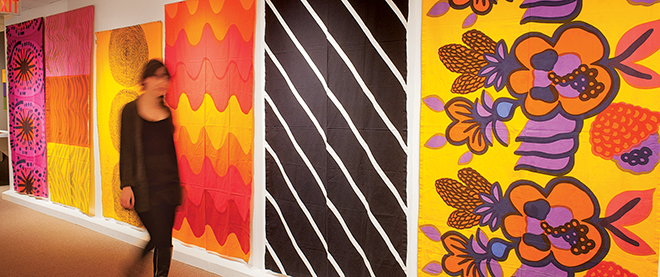How Marimekko became a way of life
‘Finnish eroticism’ comes home to Canada
PHOTOGRAPHS BY ANDREW TOLSON
Share

It was an unprepossessing start in 1959. Karelia, which was to become the community centre for the Toronto design intelligentsia, made its debut squeezed into a hair salon on Bayview Avenue, next door to the Norwegian Ski Shop. Janis Kravis, a Latvian immigrant and newly graduated architect, had landed exclusive rights to import Marimekko textiles from Finland. In the ’60s, Karelia moved downtown to Front Street and became a mecca for young intellectuals and designers, and for young couples eschewing the traditional Birks tableware and Ridpath’s reproduction furniture for something very different in their modern international homes. Recently Kravis recalled the glory days. “On a Saturday morning in the ’60s, Karelia was crammed. The in-store coffee shop—that was a first—was so full people spilled out onto the stairs. I could look up and see Toronto’s major architects all sitting there talking.”
Despite the monotonous suburban postwar housing that dominated the Toronto landscape, there were hints of change. Eaton’s sold Danish modern teak furniture. A fashionable new crowd had come to town. When Kravis was a young University of Toronto architecture grad, he started working with the modernist architectural firm of John C. Parkin, where he met Finnish architect Viljo Revell and his colleagues, who had won the international design competition for the controversial new Toronto city hall. They told Kravis to visit Finland, where he was quickly enfolded in the arms and the world of Armi Ratia, a charismatic force. In 1951 she had turned her husband’s postwar oilcloth company into Marimekko.
Sixty years later, Marimekko’s iconic red poppy prints are found not just on bedding and kitchenware but even crammed onto Converse shoes, a far cry from the original large poppies on fabrics hanging like works of art or draped above a public space to bring the ceiling level down.
At marimekko, with love, an exhibition opening this week for three months at the Textile Museum of Canada, visitors will be able to flop onto Montreal-made Fat Boy poppy beanbag chairs and see New Wall’s Marimekko wallpaper, as well as the still available textile, and what the Marimekko way of life looked like. It was Kravis and his Karelia stores that brought Ratia’s “way of living” to Toronto, and then Vancouver and Edmonton.
Ratia didn’t mince words: “One has to dream, and one must stand out from the rest.” Apparently, she really stood out at a party, entertaining friends, associates and family at her country manor house. “There was a naturalness at her parties,” Kravis reminisced. “The saunas, running around naked afterwards. There’s a kind of Finnish eroticism that shows in their creative spirit and zest for life.”
Ratia was certainly creative. “I really don’t sell clothes, I sell a way of living,” she said. “My approach is something like an architect’s. He makes a house for people to live in. I make a dress for women to live in. The Marimekko woman is easily recognized. Her style in wearing dresses is to forget them.”
Ratia’s approach—selling not just clothes but fabrics for wearers to sew their own, with the fabrics appearing first as artworks and furnishings—made Marimekko the first lifestyle brand, an approach ahead of its time.
Yet for all the acclaim, Marimekko’s finances often suffered under Ratia’s leadership. When she died in 1979, fashion was no longer into Marimekko’s pop-art, shake-up-the-world looks. Marimekko was bought in 1991 by Finn Kirsti Paakkanen, and now has stores around the world, including two dozen concept stores in Japan, and a successful partnership with Crate and Barrel. On a smaller scale, but perhaps truer to the original ideals, Kravis’s son has just opened Karelia Kitchen in Toronto, which specializes in Scandinavian sandwiches.